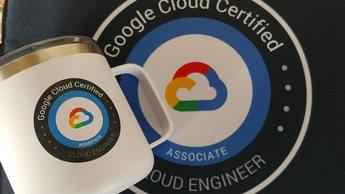
Google Analytics: Google Analytics Individual Qualification (IQ)
PDFs and exam guides are not so efficient, right? Prepare for your Google examination with our training course. The Google Analytics course contains a complete batch of videos that will provide you with profound and thorough knowledge related to Google certification exam. Pass the Google Google Analytics test with flying colors.

Curriculum for Google Analytics Certification Video Course
| Name of Video | Time |
|---|---|
 1. Course Overview |
01:01 |
 2. Why Google Analytics Is So Valuable (3 Practical Examples) |
06:55 |
 3. How to Use Analytics Intelligence (New Feature) |
06:50 |
| Name of Video | Time |
|---|---|
 1. How to Create Your Google Analytics Account |
03:48 |
 2. How to Install Tracking Code |
03:02 |
 3. How to Add Backup Views |
03:05 |
 4. How to Add Filters to Remove Internal Traffic |
02:39 |
 5. How to Load Demo Account (Skip If You Have a Website) |
02:32 |
| Name of Video | Time |
|---|---|
 1. How to Navigate Google Analytics (Guided Tour for Beginners) |
06:14 |
 2. How to Use Reports & Manipulate the Data (Key Features Overview) |
10:59 |
 3. How to Use Real Time Reports + Use Cases |
04:02 |
 4. How to Analyze Audience Reports to Pinpoint Your Best Customers |
09:25 |
 5. How to Analyze Acquisition Reports to Increase Traffic & Sales |
06:25 |
 6. How to Analyze Behaviour Reports to Find Your Most Popular Content |
05:09 |
 7. How to Track the Success of Marketing Campaigns with Campaign Tagging |
03:34 |
 8. How to Use Segments to Get Even More Insights |
04:40 |
 9. How to Configure Goals to Track Performance |
06:45 |
| Name of Video | Time |
|---|---|
 1. How to Remove Spam Traffic |
02:42 |
 2. How to Set Up Custom Alerts |
03:15 |
 3. How to Link Google Adwords to Google Analytics |
01:39 |
 4. How To Add Colleagues to Google Analytics |
01:54 |
Google Google Analytics Exam Dumps, Practice Test Questions
100% Latest & Updated Google Google Analytics Practice Test Questions, Exam Dumps & Verified Answers!
30 Days Free Updates, Instant Download!
Google Analytics Premium Bundle

- Premium File: 70 Questions & Answers. Last update: Dec 6, 2025
- Training Course: 21 Video Lectures
- Latest Questions
- 100% Accurate Answers
- Fast Exam Updates
Google Google Analytics Training Course
Want verified and proven knowledge for Google Analytics Individual Qualification (IQ)? Believe it's easy when you have ExamSnap's Google Analytics Individual Qualification (IQ) certification video training course by your side which along with our Google Google Analytics Exam Dumps & Practice Test questions provide a complete solution to pass your exam Read More.
Learn Google Analytics from Scratch: Step-by-Step Website Analytics Course
Master Google Analytics to Grow Your Business, Guided by an Award-Winning Digital Marketing Agency Founder, with Hands-On GA4 Training
Course Overview
Google Analytics has become an essential tool for anyone looking to understand how users interact with their websites. Whether you run a small business, manage an online store, or maintain a personal blog, knowing how your audience behaves online can give you a competitive advantage. This course is designed to provide beginners with a solid foundation in website analytics, focusing on the practical skills needed to track website traffic, interpret visitor behavior, and optimize online performance. By the end of this training, participants will be able to confidently navigate the Google Analytics platform, set up tracking, and use data to make informed decisions.
Google Analytics allows you to collect, measure, and analyze data related to your website’s performance. Understanding these insights is crucial for digital marketing, content strategy, and business growth. Beginners often feel overwhelmed by the multitude of features and reports, but this course simplifies complex concepts into actionable steps. From account setup to interpreting the analytics dashboard, the course offers structured guidance to help learners gain confidence in tracking and analyzing website activity.
Throughout the modules, participants will explore different traffic sources, including organic search, referral traffic, and social media campaigns. They will also learn to set up conversion tracking, create goals, and monitor user interactions in real time. This approach ensures that learners not only understand the theory behind analytics but also acquire practical skills that can be applied immediately to improve online performance.
What You Will Learn From This Course
How to create and configure a Google Analytics account for your website
Installation and verification of tracking codes, including GA4 setup
Navigating the Google Analytics dashboard and understanding core metrics
Tracking website traffic, including organic, paid, and referral sources
Identifying audience demographics, behavior patterns, and device usage
Monitoring real-time user activity to assess immediate website performance
Setting up goals, events, and conversions to measure business objectives
Leveraging reports to optimize digital marketing campaigns and content strategies
Integrating Google Analytics with other tools, such as Google Ads
Using data-driven insights to improve user experience and engagement
By the end of this course, participants will feel comfortable interpreting analytics data and using it to drive actionable decisions. Each lesson builds progressively, ensuring that beginners develop a thorough understanding of both foundational and intermediate concepts.
Learning Objectives
The learning objectives of this course are designed to equip participants with a comprehensive understanding of website analytics for online business growth. Upon completing this course, learners will be able to:
Understand the importance of analytics in digital marketing and online business strategies
Configure Google Analytics accounts to capture relevant data accurately
Identify key metrics that reflect website performance, including user sessions, bounce rates, and conversion rates
Analyze audience behavior, traffic sources, and content performance
Implement tracking for events, goals, and eCommerce transactions
Utilize analytics reports to optimize marketing campaigns, improve user experience, and drive business growth
Interpret complex data into actionable insights for decision-making
Stay updated with GA4 enhancements and leverage its features for advanced tracking
These objectives ensure that beginners not only gain technical skills but also develop the analytical mindset needed to transform raw data into meaningful insights. By mastering these objectives, learners will be able to monitor and optimize their online presence effectively.
Requirements
This course is designed with beginners in mind, so no prior knowledge of Google Analytics is required. However, learners should have a basic understanding of the following:
General familiarity with the internet and web browsing
Basic understanding of websites, web pages, and online content
Access to a Google account to set up Google Analytics
A website or test site to practice implementing tracking codes and monitoring traffic
Curiosity and willingness to learn data analysis concepts in a practical context
While advanced programming skills are not necessary, learners who are comfortable navigating web platforms and managing online content will benefit from a smoother learning experience. The course is structured to gradually introduce technical concepts, ensuring that beginners can follow along without feeling overwhelmed.
Course Description
The Ultimate Google Analytics Course for Beginners is a comprehensive training program aimed at helping individuals understand and utilize website analytics effectively. The course focuses on hands-on learning and practical application, allowing participants to gain real-world experience in tracking and analyzing website performance.
Google Analytics is an essential tool for anyone involved in digital marketing, content creation, or online business management. By tracking user interactions, website owners can identify trends, assess campaign performance, and make informed decisions that enhance overall digital strategy. This course breaks down the platform into manageable sections, covering everything from account setup to advanced reporting features.
Participants will start by learning how to create a Google Analytics account, install tracking codes, and verify data collection. Subsequent modules will explore the dashboard interface, guiding learners through various reports that highlight user behavior, traffic sources, and content engagement. The course also emphasizes conversion tracking, teaching participants how to define goals and measure business outcomes effectively.
In addition to standard tracking and reporting, this course introduces learners to GA4, the latest version of Google Analytics. GA4 offers enhanced measurement options, event tracking, and integration with other Google tools. By familiarizing learners with these features, the course ensures that participants are prepared to utilize modern analytics techniques to improve website performance and marketing effectiveness.
Target Audience
This course is designed for a wide range of learners who wish to develop expertise in website analytics. The primary audience includes:
Small business owners who want to understand website performance and drive growth through data
Digital marketers seeking to enhance campaign effectiveness and optimize ROI
Bloggers and content creators looking to track audience engagement and improve content strategy
E-commerce managers who need to monitor sales funnels and user behavior
Students and professionals interested in learning digital analytics as a career skill
The course is beginner-friendly, making it accessible for individuals with minimal prior experience in analytics or digital marketing. By offering clear instructions, practical examples, and step-by-step guidance, the course ensures that all participants can achieve meaningful outcomes.
Prerequisites
Before starting this course, learners should ensure they have the following:
A Google account to access Google Analytics and related tools
Basic understanding of websites, including familiarity with web pages, URLs, and hosting platforms
A functional website or a test environment for practicing tracking and analytics implementation
Basic computer literacy, including navigating software, browsers, and online platforms
Interest in data analysis and willingness to engage with metrics to improve online performance
No prior experience in analytics, coding, or digital marketing is required. The course is structured to gradually introduce new concepts, making it suitable for complete beginners while still providing valuable insights for those with some experience.
Introduction to Google Analytics and Its Importance
Website analytics is more than just numbers; it is a gateway to understanding user behavior and making informed decisions. Google Analytics is a widely used platform that allows website owners and marketers to track and analyze various aspects of website performance. It provides insights into user behavior, traffic sources, content engagement, and conversions, enabling businesses to optimize their online presence effectively.
By learning how to use Google Analytics, beginners can uncover patterns in visitor activity, identify which marketing channels generate the most traffic, and understand how users interact with website content. This knowledge is crucial for optimizing digital marketing campaigns, improving user experience, and ultimately increasing revenue.
The platform also helps in identifying potential issues, such as pages with high bounce rates, low engagement, or technical errors. By addressing these challenges, website owners can enhance performance and maintain a competitive edge in the digital landscape.
Setting Up Your Google Analytics Account
The first step in leveraging the power of Google Analytics is creating an account. Beginners should start by signing in with a Google account and setting up a property for their website. Google now recommends using GA4, which provides more advanced tracking features compared to Universal Analytics.
Once the account is created, learners will install the tracking code on their website. This code collects data on user interactions, including page views, clicks, and other engagement metrics. It is essential to verify that the tracking code is working correctly to ensure accurate data collection.
For those managing multiple websites or online properties, Google Analytics allows the creation of multiple properties under a single account. This feature simplifies tracking and reporting across different platforms, enabling a holistic view of website performance.
Understanding the Analytics Dashboard
The Google Analytics dashboard is the central hub for all website performance data. Beginners will explore various sections, including real-time reports, audience demographics, acquisition channels, behavior metrics, and conversion tracking.
Real-time reports show current user activity, allowing website owners to monitor live interactions and assess immediate performance. Audience reports provide insights into visitor demographics, location, devices, and engagement patterns. Acquisition reports highlight traffic sources, including organic search, paid campaigns, and referrals from other websites. Behavior reports help analyze content performance, user flow, and engagement levels. Conversion tracking allows measurement of goals, such as newsletter sign-ups, purchases, or other business objectives.
Understanding the dashboard enables learners to navigate reports efficiently, interpret data accurately, and derive actionable insights for decision-making.
Tracking Website Traffic
Tracking website traffic is one of the core functions of Google Analytics. Beginners will learn to differentiate between various traffic sources, including organic search, paid advertising, social media, and referral traffic. By analyzing these sources, learners can identify which channels drive the most visitors, engagement, and conversions.
Organic traffic comes from search engines and reflects the effectiveness of search engine optimization strategies. Paid traffic includes visitors from advertisements, allowing measurement of return on investment and campaign performance. Referral traffic comes from external websites linking to your content, offering opportunities for partnerships and collaborations.
Tracking traffic patterns over time helps in identifying trends, understanding user behavior, and optimizing marketing strategies for maximum impact.
Course Modules/Sections
This course is divided into carefully structured modules to provide a comprehensive understanding of Google Analytics for beginners. Each module builds upon the previous one, gradually introducing learners to more advanced features while ensuring practical application of knowledge.
The course begins with foundational concepts, including an introduction to website analytics, the importance of tracking user behavior, and an overview of the Google Analytics platform. Learners will then move on to account setup, installing tracking codes, and verifying proper data collection. These initial sections ensure that beginners gain confidence in using Google Analytics before exploring more advanced topics.
Subsequent modules focus on understanding the analytics dashboard, interpreting key metrics, and analyzing audience behavior. Learners will explore traffic sources, engagement patterns, and content performance reports, enabling them to make data-driven decisions for marketing and website optimization.
The course also includes modules dedicated to conversion tracking, goal setting, and event tracking, allowing participants to measure the effectiveness of marketing campaigns and online business objectives. Advanced sections introduce GA4 features, including custom events, enhanced measurement, and integration with other Google tools such as Google Ads.
Finally, the course provides practical applications, including case studies, hands-on exercises, and data analysis projects. This structure ensures that beginners can not only understand analytics concepts but also apply them effectively to real-world scenarios, improving website performance and marketing outcomes.
Key Topics Covered
The course covers a wide range of topics to ensure a thorough understanding of Google Analytics and its application to online business. These topics include:
Introduction to Google Analytics: Understanding the purpose of website analytics and its relevance to digital marketing and online business growth.
Setting Up Accounts and Properties: Creating a Google Analytics account, configuring website properties, and installing tracking codes for accurate data collection.
GA4 Overview: Exploring the latest version of Google Analytics, including enhanced measurement features, custom events, and integration with other tools.
Analytics Dashboard Navigation: Learning to navigate real-time reports, audience insights, acquisition data, behavior metrics, and conversion tracking.
Traffic Analysis: Differentiating between organic, paid, referral, and social traffic sources, and understanding their impact on website performance.
Audience Insights: Analyzing user demographics, geographic location, device usage, and engagement patterns to inform marketing strategies.
Content Performance: Identifying high-performing pages, understanding user flow, and optimizing content for better engagement.
Conversion Tracking and Goals: Setting up measurable goals, monitoring conversions, and assessing the effectiveness of marketing campaigns.
Event Tracking: Implementing custom events to capture user interactions beyond standard page views, such as clicks, downloads, and video views.
E-commerce Analytics: Tracking sales, product performance, and customer behavior to optimize online store operations.
Integration with Google Ads: Linking Google Analytics with advertising campaigns to measure ROI and improve targeting.
Data Interpretation: Learning how to analyze complex data sets, generate actionable insights, and apply findings to enhance digital marketing strategies.
These topics are covered through a combination of theoretical explanations, practical examples, and hands-on exercises, ensuring that beginners develop both understanding and application skills.
Teaching Methodology
The teaching methodology of this course is designed to be engaging, interactive, and practical, ensuring that learners gain both theoretical knowledge and hands-on experience. The approach includes:
Step-by-Step Demonstrations: Each concept is explained in a structured, step-by-step manner, allowing learners to follow along easily. Visual demonstrations of the Google Analytics dashboard, report generation, and tracking implementation ensure clarity and understanding.
Hands-On Exercises: Learners apply concepts immediately through exercises such as setting up accounts, installing tracking codes, and analyzing real-time data. These exercises help reinforce learning and provide practical experience.
Real-World Examples: Case studies and examples from actual websites are incorporated to demonstrate the practical application of analytics concepts. Learners can see how data-driven decisions improve marketing campaigns and website performance.
Interactive Quizzes and Assessments: Short quizzes and knowledge checks are included throughout the modules to test comprehension and reinforce learning objectives. These assessments provide feedback and help learners identify areas for improvement.
Guided Projects: Learners undertake projects that involve analyzing website traffic, interpreting reports, and creating actionable insights. These projects simulate real-world scenarios, preparing participants for professional application of Google Analytics skills.
Incremental Learning: The course is structured so that each module builds on previous knowledge. Beginners start with foundational concepts and gradually move to more advanced features, ensuring a smooth learning curve.
Supplemental Resources: Additional resources, including tutorials, guides, and templates, are provided to support learning and allow learners to explore concepts in greater depth.
This methodology ensures that beginners gain confidence in navigating Google Analytics, understanding data, and applying insights to improve website performance and marketing effectiveness.
Assessment & Evaluation
Assessment and evaluation in this course are designed to measure learners’ understanding of key concepts, practical application skills, and ability to interpret analytics data effectively. The evaluation framework includes:
Module Quizzes: Each module includes quizzes to assess comprehension of key topics. These quizzes cover both theoretical concepts and practical application, ensuring that learners grasp essential skills.
Hands-On Assignments: Assignments require learners to implement tracking codes, configure goals, and analyze website data. This practical approach ensures that learners can apply concepts to real-world scenarios.
Case Study Analysis: Learners evaluate case studies that demonstrate how businesses use Google Analytics to optimize performance. They are tasked with identifying insights, proposing solutions, and recommending strategies based on data interpretation.
Project-Based Evaluation: Learners complete a capstone project involving comprehensive data analysis. This includes tracking website traffic, interpreting user behavior, setting up goals, and generating reports. Projects are evaluated based on accuracy, insightfulness, and application of analytics techniques.
Participation and Engagement: Active participation in discussions, exercises, and interactive sessions contributes to assessment. Engaged learners demonstrate practical understanding and the ability to collaborate on data-driven solutions.
Feedback and Review: Continuous feedback is provided throughout the course. Learners receive guidance on improving analysis, optimizing tracking setups, and interpreting reports effectively.
The assessment framework ensures that learners not only understand Google Analytics concepts but also develop the practical skills necessary to implement tracking, analyze data, and make informed decisions for online business growth.
Introduction to Website Analytics
Website analytics is a critical component of online business strategy. In this module, learners explore the fundamental principles of analytics, including why tracking user behavior is essential and how data-driven decisions can improve website performance. Topics covered include understanding website metrics, identifying key performance indicators, and the role of Google Analytics in monitoring traffic, engagement, and conversions.
Beginners are introduced to the Google Analytics platform, with a focus on familiarizing themselves with the interface and basic navigation. Real-time reporting is demonstrated to show how visitors interact with a website at any given moment. Learners also explore the audience reports, which provide insights into demographics, interests, location, and device usage.
This module emphasizes the practical importance of analytics, highlighting how businesses can leverage insights to enhance user experience, optimize content, and improve marketing campaigns. Through exercises and examples, learners begin to see the value of data-driven decision-making in a digital context.
Setting Up Google Analytics
The second module focuses on account creation, property configuration, and tracking code installation. Learners are guided step by step through creating a Google Analytics account and setting up a property for their website. The module also covers GA4 setup, including enhanced measurement features and event tracking.
Participants practice installing the tracking code on a website and verifying proper data collection. The module includes troubleshooting tips for common issues, such as incorrect tracking code placement or missing data. Learners are also introduced to Google Tag Manager, which simplifies the implementation of tracking codes and event monitoring.
By the end of this module, learners are equipped with the technical knowledge to set up Google Analytics correctly, ensuring accurate and reliable data collection for subsequent analysis.
Understanding Metrics and Reports
This module dives into interpreting data from the Google Analytics dashboard. Beginners learn about key metrics, such as sessions, users, page views, bounce rate, and average session duration. Learners also explore traffic sources, identifying where visitors come from and which channels drive the most engagement.
Audience reports are analyzed to understand demographics, interests, and user behavior patterns. Behavior reports highlight how users navigate the site, including popular pages, entry and exit points, and content performance. Conversion tracking is introduced, teaching learners how to define and monitor goals such as form submissions, newsletter sign-ups, or e-commerce transactions.
Interactive exercises allow learners to practice reading reports, identifying trends, and generating insights that can inform marketing and website optimization strategies.
Tracking Traffic Sources
Understanding where website visitors come from is essential for effective digital marketing. This module explores organic search, paid campaigns, social media referrals, and direct traffic. Learners analyze the impact of each source on user engagement and conversion rates, identifying which channels provide the best return on investment.
Techniques for monitoring traffic patterns over time are introduced, including using date ranges, segments, and custom reports. Learners also explore referral data to identify opportunities for partnerships and outreach campaigns.
Hands-on exercises allow participants to evaluate real or test data, interpret trends, and propose strategies for optimizing traffic sources. By the end of this module, learners can confidently track website performance across multiple channels and make informed marketing decisions.
Goal Setting and Conversion Tracking
Conversion tracking is critical for measuring business outcomes. In this module, learners define measurable goals, such as purchases, form completions, or downloads. Step-by-step instructions are provided to set up goals in GA4 and monitor performance over time.
Event tracking is also introduced to capture user interactions beyond standard page views. Learners learn to track clicks, video plays, downloads, and other engagement metrics. This data provides a comprehensive view of user behavior, allowing businesses to optimize conversion funnels and improve overall website performance.
Exercises involve creating goals, setting up events, and generating reports that illustrate goal completion and conversion rates. This practical application reinforces learning and ensures participants can implement tracking effectively.
Benefits of the Course
Enrolling in this Google Analytics course provides numerous benefits for beginners and professionals alike. Understanding website analytics is essential for anyone looking to optimize online performance, increase user engagement, and make data-driven decisions.
One of the primary benefits is gaining the ability to monitor website traffic accurately. Learners will understand where visitors come from, how they interact with content, and which channels drive the most conversions. This insight allows website owners and marketers to tailor their strategies, focusing efforts on high-performing channels and improving weaker ones.
Another significant advantage is mastering the analytics dashboard. Beginners often feel overwhelmed by the variety of reports and metrics, but this course breaks down each component into clear, understandable sections. By learning to navigate the dashboard efficiently, participants can quickly access real-time data, audience insights, and behavioral metrics, enabling timely and informed decision-making.
Conversion tracking and goal setup are also key benefits. The course teaches learners how to define measurable objectives, such as newsletter subscriptions, purchases, or downloads, and track them effectively. This ensures that marketing campaigns and website improvements are aligned with business objectives, resulting in better ROI and optimized performance.
Participants will also gain skills in content performance analysis. By identifying high-performing pages and understanding user flow, learners can optimize content strategy, improve engagement, and enhance user experience. These insights are invaluable for bloggers, e-commerce managers, and digital marketers who want to maximize the impact of their online presence.
In addition, the course covers GA4 features, which offer advanced tracking options, enhanced measurement capabilities, and integration with other Google tools. Familiarity with GA4 ensures that learners are up to date with current industry standards, enabling them to apply modern analytics techniques for professional growth.
Hands-on exercises and practical projects provide real-world experience. Learners will apply tracking codes, analyze reports, and generate insights that can be implemented immediately. This practical approach ensures that the knowledge gained is not only theoretical but also actionable, enhancing the learner’s ability to make informed decisions based on analytics data.
Finally, the course fosters analytical thinking. By interpreting data, identifying trends, and proposing solutions, learners develop the critical skills needed to evaluate website performance continuously. This ability is essential for businesses that want to stay competitive in a digital-first landscape.
Course Duration
The duration of the course is designed to provide a thorough and balanced learning experience for beginners. The total course length is approximately 20 hours, distributed across multiple modules to ensure gradual learning and practical application.
The first few modules, which cover foundational concepts, account setup, and tracking code implementation, typically take around 5 to 6 hours. These modules are essential for ensuring that learners can navigate the Google Analytics platform and understand core metrics accurately.
Intermediate modules, focusing on dashboard navigation, traffic source analysis, and audience insights, require an additional 6 to 7 hours. During this time, learners practice analyzing reports, interpreting user behavior, and generating actionable insights. Hands-on exercises reinforce the theoretical knowledge and help participants develop confidence in using analytics tools.
The final modules, which cover conversion tracking, goal setup, event monitoring, GA4 advanced features, and project-based applications, take approximately 7 to 8 hours. These sections provide practical experience with real-world scenarios, ensuring that learners can apply their knowledge effectively.
Learners are encouraged to progress at their own pace, revisiting modules and exercises as needed to reinforce understanding. The course structure allows flexibility, making it suitable for professionals balancing other responsibilities while acquiring new skills.
In addition to structured learning hours, supplementary resources, including guides, tutorials, and case studies, are provided. Learners may spend additional time reviewing these materials to deepen their understanding of specific concepts, such as custom event tracking, e-commerce analytics, and integration with marketing campaigns.
Overall, the course duration ensures a comprehensive learning experience without overwhelming beginners. By combining structured lessons with hands-on practice and supplemental materials, participants can master Google Analytics effectively and efficiently.
Tools & Resources Required
To maximize the learning experience and ensure practical application, certain tools and resources are recommended for this course. These resources help learners implement tracking, analyze data, and practice real-world scenarios.
Google Account: A Google account is required to access Google Analytics and related tools. This account provides access to GA4 properties, reporting dashboards, and integrations with other Google products.
Website or Test Site: Learners should have access to a website or test environment for implementing tracking codes and monitoring user activity. This practical experience is essential for understanding how analytics data is collected and interpreted.
Web Browser: A modern web browser, such as Chrome, Firefox, or Edge, is necessary for accessing Google Analytics, dashboards, and reports. Browser extensions like Google Tag Assistant can also assist in verifying tracking code implementation.
Google Tag Manager (Optional but Recommended): Tag Manager simplifies the process of managing tracking codes, events, and conversions without modifying website code directly. Learners using Tag Manager gain additional flexibility and efficiency in implementing analytics tracking.
Spreadsheet Software: Tools like Microsoft Excel or Google Sheets are helpful for organizing data, performing calculations, and creating visualizations. Spreadsheet use allows learners to analyze exported reports, track trends, and generate insights beyond the Google Analytics interface.
Learning Materials: Access to tutorials, guides, and course-provided resources enhances understanding. Supplemental materials may include example reports, case studies, and best practices for interpreting data.
Optional Analytics Tools: While Google Analytics is the primary platform, familiarity with other tools such as Google Ads, Search Console, or social media analytics platforms can provide additional context and enable cross-platform insights.
Internet Access: Reliable internet access is required for real-time reporting, accessing dashboards, and using cloud-based resources such as GA4 and Tag Manager.
These tools and resources collectively ensure that learners can apply concepts in a practical environment, track website performance accurately, and generate actionable insights. By using these resources, beginners gain hands-on experience that bridges theory and real-world application.
Career Opportunities
Mastering Google Analytics opens a wide range of career opportunities in the digital marketing and analytics space. Businesses of all sizes rely on data to make informed decisions, and professionals who can interpret website performance metrics are in high demand.
One of the most common career paths is that of a digital marketing analyst. In this role, individuals use analytics data to evaluate campaign performance, track user behavior, and optimize marketing strategies. Analysts work with various online platforms, including social media, search engines, and email marketing tools, leveraging insights from Google Analytics to drive growth and improve ROI.
Another potential career is web analyst or data analyst, where professionals focus on understanding website traffic, user engagement, and conversion performance. These roles often involve creating custom reports, generating dashboards, and providing actionable recommendations to improve website performance. Web analysts use GA4 features extensively to track events, monitor user interactions, and measure the effectiveness of content and campaigns.
For those interested in e-commerce, becoming an e-commerce analyst or digital commerce strategist is an excellent option. These roles focus on monitoring online sales, evaluating product performance, and identifying opportunities to optimize sales funnels. Professionals in these positions use data to improve user experience, increase conversions, and maximize revenue.
Marketing roles such as SEO specialist and PPC (Pay-Per-Click) manager also benefit significantly from Google Analytics expertise. SEO specialists use traffic data to optimize content for search engines, identify high-performing keywords, and improve organic traffic. PPC managers rely on GA4 insights to track paid campaign performance, measure ROI, and adjust bids or targeting strategies.
Additionally, freelancing and consultancy opportunities are available for individuals who have mastered Google Analytics. Businesses often hire freelance analysts or consultants to set up tracking, create reports, and provide strategic recommendations. This path allows flexibility, remote work options, and the potential to work with clients across different industries.
For beginners who complete the course and gain practical experience, opportunities also exist in content marketing, social media management, and digital strategy roles, where analytics skills complement creative and strategic decision-making. Understanding user behavior, tracking conversions, and interpreting performance metrics are valuable skills that enhance overall effectiveness in these positions.
Overall, proficiency in Google Analytics equips learners with a versatile skill set that applies across multiple industries and career paths. Whether pursuing full-time roles, freelance opportunities, or entrepreneurial ventures, knowledge of analytics provides a competitive edge in the digital marketplace.
Enroll Today
Taking the step to enroll in this Google Analytics course provides immediate access to structured, practical, and beginner-friendly training. By signing up, learners gain the knowledge, skills, and confidence required to navigate the Google Analytics platform, track website traffic, and interpret data effectively.
Enrollment ensures access to all course modules, covering foundational concepts, dashboard navigation, traffic analysis, conversion tracking, GA4 advanced features, e-commerce analytics, custom reporting, and data interpretation. Learners will also benefit from hands-on exercises, real-world case studies, and practical projects that reinforce theoretical knowledge and provide practical experience.
Participants can progress at their own pace, revisiting lessons and exercises as needed to ensure mastery of concepts. The course structure allows beginners to build a solid foundation while gradually exploring advanced features and practical applications.
By enrolling today, learners also gain access to supplemental resources, including tutorials, guides, templates, and best practices, which enhance understanding and provide tools for ongoing analytics practice. These resources support continued learning beyond the course, enabling participants to stay updated with evolving GA4 features and digital marketing trends.
The course provides an opportunity to gain a competitive advantage in the digital landscape. Understanding website performance, audience behavior, and conversion metrics empowers learners to make data-driven decisions that enhance online business outcomes. From optimizing marketing campaigns to improving user experience, the skills acquired through this course have immediate and practical applications.
Enrollment also opens doors to career advancement. With proficiency in Google Analytics, learners can pursue roles in digital marketing, web analysis, e-commerce strategy, and data-driven business consulting. Freelancers and entrepreneurs can leverage analytics expertise to optimize their own websites or provide consulting services to clients.
The process to enroll is straightforward. Interested participants need a Google account to access the platform, a website or test environment to practice tracking implementation, and basic computer literacy. Once enrolled, learners can access all modules, exercises, and resources, beginning a structured journey from beginner to confident Google Analytics user.
Enrolling today is a commitment to professional growth and skill development. The knowledge gained will not only improve website performance but also equip learners with transferable skills applicable across multiple industries. By starting this course, participants take a proactive step toward becoming proficient in digital analytics, enhancing career prospects, and making data-driven business decisions.
Prepared by Top Experts, the top IT Trainers ensure that when it comes to your IT exam prep and you can count on ExamSnap Google Analytics Individual Qualification (IQ) certification video training course that goes in line with the corresponding Google Google Analytics exam dumps, study guide, and practice test questions & answers.
Purchase Individually



Google Training Courses













Only Registered Members can View Training Courses
Please fill out your email address below in order to view Training Courses. Registration is Free and Easy, You Simply need to provide an email address.
- Trusted by 1.2M IT Certification Candidates Every Month
- Hundreds Hours of Videos
- Instant download After Registration






